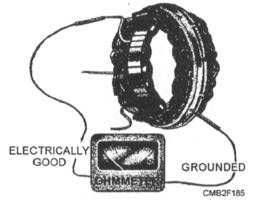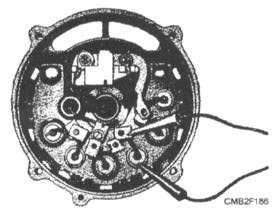the stator frame (fig. 2-32) indicates the windings are not grounded. It is not practical to test the stator for shorts due to the very low resistance of the winding.
DIODE TESTING. - With the stator windings disconnected, each diode may be tested with an ohmmeter or with a test light. To perform the test with an ohmmeter, proceed as follows:
Connect one ohmmeter test lead to the diode lead and the other to the diode case (fig. 2-33). Note the reading. Then reverse the ohmmeters leads to the diode and again note the reading. If both readings are very low or very high, the diode is defective. A good diode will give one low and one high reading.
An alternate method of testing each diode is to use a test lamp with a 12-volt battery. To perform a test with a test lamp, proceed as follows:
Connect one of the test leads to the diode lead and the other test lead as shown in figure 2-34. Then reverse the lead connections. If the lamp lights in both checks, the diode is defective. Or, if the lamp fails to light in either direction, the diode is defective. When a good diode is being tested, the lamp will light in only one of the two checks.

Figure 2-32. - Testing a stator for grounds.

Figure 2-33. - Testing diodes with an ohmmeter.

Figure 2-34. - Testing diodes with a test lamp.
After completing the required test and making any necessary repairs or replacement of parts, reassemble the alternator and install it on the vehicle. After installation, start the engine and check that the charging system is functioning properly. NEVER ATTEMPT TO POLARIZE AN ALTERNATOR. Attempts to do so serves no purpose and may damage the diodes, wiring, and other charging circuit components.
CHARGING SYSTEM TEST
Charging system tests should be performed when problems point to low alternator voltage and current. These tests will quickly determine the operating condition of the charging system. Common charging system tests are as follows:
Charging system output test-measures current and voltage output of the charging system.
Regulator voltage test - measures charging system voltage under low output, low load conditions.
Regulator bypass test - connects full battery voltage to the alternator field, leaving the regulator out of the circuit.
Circuit resistance tests - measures resistance in insulted and grounded circuits of the charging system.
Charging system tests are performed in two ways - by using a load tester or by using a volt-ohm- millimeter (VOM/multimeter). The load tester provides the accurate method for testing a charging system by measuring both system current and voltage.
Continue Reading